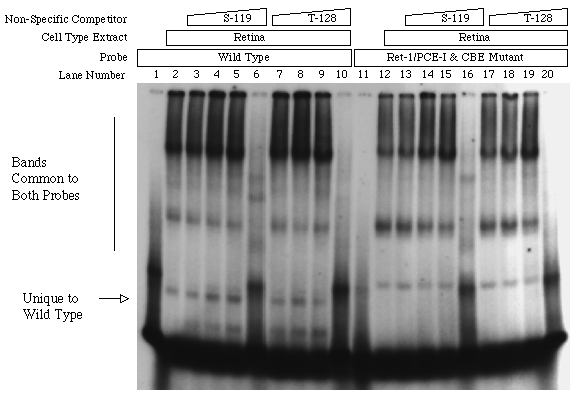![]() Figure 10 of
Boatright, Mol Vis 3:15, 1997.
Figure 10 of
Boatright, Mol Vis 3:15, 1997.
Figure 10. EMSA of wild-type and mutant activator sequence probing against extracts from cultured chick retinal cells.
The -70 to -45 sequence of the murine IRBP promoter, with or without base transversions in Ret-1/PCE-I and the CRX-binding element (CBE) (see Figure 1) were radiolabeled and incubated with nuclear extracts from E10 retina cells plated four days prior to harvesting. Incubates were then electrophoresed across 5% nondenaturing polyacrylamide gels. Radioactivity was later visualized by autoradiography. Bands appeared in lanes containing both probes, however, one band (arrow) was present specifically in Wild Type lanes. A band that appears specific for the mutant is also in lanes without extract (lanes 1 and 11), suggesting that it is artifactual. Four types of nonspecific DNA-binding competitors were tested at increasing concentrations (0, 0.0625, 0.625, 6.25, and 62.5 ng/µl) to determine the effect of dispersing nonspecific protein aggregates. Results with all dispersants were similar; the polymeric dyes S-119 and T-128 were used in this representative experiment. The activator-specific band is seen at all concentrations of dispersant except for the highest (lanes 6,10, 16, and 20), a condition in which probably all binding is precluded. Note that other bands that appear to be wild type-specific did not reliably appear in all experiments.
